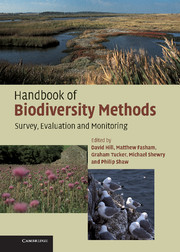Book contents
- Frontmatter
- Contents
- Preface
- Acknowledgements
- Part I Planning
- Part II Habitats
- Part III Species
- 9 Introduction to species assessment
- 10 General principles and methods for species
- 11 Fungi
- 12 Lichens
- 13 Bryophytes
- 14 Aquatic macrophytes and algae
- 15 Vascular plants
- 16 Dragonflies and damselflies
- 17 Butterflies
- 18 Moths
- 19 Other terrestrial invertebrates
- 20 Aquatic invertebrates
- 21 Fish
- 22 Amphibians
- 23 Reptiles
- 24 Birds
- 25 Bats
- 26 Other mammals
- Appendix 1 Monitoring and reporting obligations under international conservation agreements
- Appendix 2 Relationship between BAP Priority Habitat and Broad Habitat categories and Habitats Directive nomenclature
- Appendix 3 Annotated list of key references for plant identification
- Appendix 4 Determining appropriate quadrat size for vegetation sampling
- Appendix 5 The relocation of permanent plots
- Appendix 6 Equipment required for undertaking different types of survey
- Recommended sources of further information
- References
- Glossary
- Index
20 - Aquatic invertebrates
Published online by Cambridge University Press: 01 September 2010
- Frontmatter
- Contents
- Preface
- Acknowledgements
- Part I Planning
- Part II Habitats
- Part III Species
- 9 Introduction to species assessment
- 10 General principles and methods for species
- 11 Fungi
- 12 Lichens
- 13 Bryophytes
- 14 Aquatic macrophytes and algae
- 15 Vascular plants
- 16 Dragonflies and damselflies
- 17 Butterflies
- 18 Moths
- 19 Other terrestrial invertebrates
- 20 Aquatic invertebrates
- 21 Fish
- 22 Amphibians
- 23 Reptiles
- 24 Birds
- 25 Bats
- 26 Other mammals
- Appendix 1 Monitoring and reporting obligations under international conservation agreements
- Appendix 2 Relationship between BAP Priority Habitat and Broad Habitat categories and Habitats Directive nomenclature
- Appendix 3 Annotated list of key references for plant identification
- Appendix 4 Determining appropriate quadrat size for vegetation sampling
- Appendix 5 The relocation of permanent plots
- Appendix 6 Equipment required for undertaking different types of survey
- Recommended sources of further information
- References
- Glossary
- Index
Summary
A considerable range of techniques are available for sampling aquatic invertebrates, a comprehensive description of which is beyond the scope of this Handbook. Section 20.2 summarises the most widely used methods, but variants have evolved for most of the techniques and equipment described. A detailed account of sampling methods is given in Hellawell (1978, 1986) and Southwood (2000). A summary can also be found in Ausden (1996) and RSPB/NRA/RSNC (1994).
The timing of any survey of aquatic invertebrates is very important. Some species may not be detectable at certain times of the year (e.g. when they have emerged as flighted adults, are present as eggs attached to vegetation, or as very small instar stages). For this reason, fluctuations in community structure occur throughout the year and for comprehensive surveys it is therefore necessary to sample in various seasons to maximise the number of species captured. The protocol developed and effort expended will vary according to the objectives.
There are also particular safety aspects to consider when working in or near water. In particular, personnel should be trained in the relevant aspects of aquatic safety and use appropriate safety equipment. Surveyors should be aware of the risk of catching Weil's disease from water contaminated with rat urine. Surveyors should work in pairs and carry mobile phones or radios if working in remote areas. These should be used to contact colleagues at agreed times to confirm that sampling is proceeding safely and according to schedule.
- Type
- Chapter
- Information
- Handbook of Biodiversity MethodsSurvey, Evaluation and Monitoring, pp. 359 - 367Publisher: Cambridge University PressPrint publication year: 2005
- 1
- Cited by

